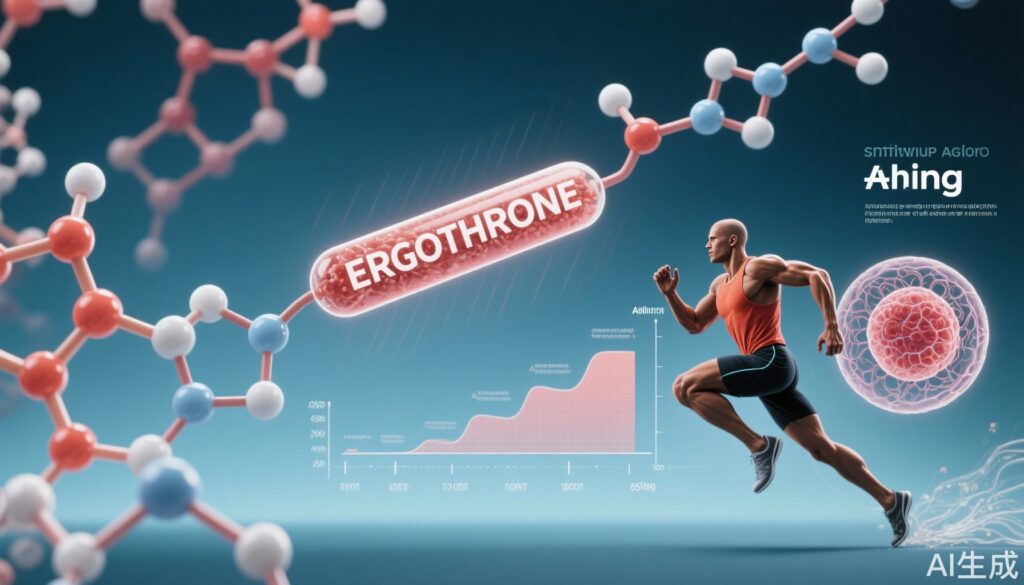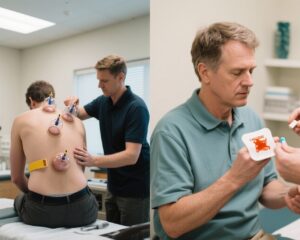Highlights
- Ergothioneine is bioavailable in humans, predominantly via mushroom consumption, and shows potential modulation of oxidative stress and lipid metabolism.
- Clinical studies reveal ergothioneine contributes to antioxidant defenses by regulating nitric oxide and thiol redox balance, though anti-inflammatory effects are inconsistent.
- Current evidence on its role in exercise-induced muscle damage indicates antioxidant benefits with limited impact on inflammation, suggesting a nuanced mechanism of action.
- Data underpinning anti-aging effects remain preliminary, requiring longitudinal and mechanistic clinical studies to establish therapeutic relevance.
Background
Ergothioneine (ET) is a naturally occurring sulfur-containing amino acid derivative recognized for its unique antioxidant properties. Predominantly found in dietary mushrooms like Agaricus bisporus and Lentinus edodes (shiitake), ET has attracted growing research attention for its potential roles in mitigating oxidative stress, decelerating aging processes, and enhancing exercise performance. Given the increasing burden of oxidative stress-related diseases, sarcopenia, and metabolic decline associated with aging, ergothioneine represents a promising candidate for clinical applications aimed at improving healthspan and physical function. Despite promising preclinical data, clarity on its clinical efficacy, bioavailability, and mechanisms remains an active research frontier, warranting careful synthesis of emerging studies.
Key Content
Chronological Development of Clinical Evidence
The pioneering studies around 2011–2013 began addressing fundamental questions on ET bioavailability and functional impact in humans. A pilot randomized crossover study by Lee et al., 2012 investigated the bioavailability and acute effects of ergothioneine administered via mushroom powder (Agaricus bisporus) in healthy males. The study demonstrated that ET is absorbed and incorporated into red blood cells postprandially, confirming bioavailability in humans. While the antioxidant capacity measured by ORAC (oxygen radical absorbance capacity) paradoxically decreased following mushroom ingestion, plasma triglyceride levels exhibited a trend toward attenuation, suggesting a modulatory effect on postprandial lipemia potentially related to ET.
Soon after, a clinical trial focusing on Lentinus edodes (shiitake) extract, rich in ergothioneine and other bioactives, evaluated its antioxidant and anti-inflammatory effects in response to prolonged eccentric exercise. This randomized, placebo-controlled crossover study involving healthy men showed that while shiitake extract increased nitric oxide (NO) concentration and improved thiol redox status—a marker of cellular antioxidant defense—it did not significantly alter exercise-induced inflammatory markers except for a rise in the anti-inflammatory cytokine IL-10. This indicated that ergothioneine’s primary contribution is likely through modulation of redox biochemical pathways rather than direct suppression of systemic inflammation.
Bioavailability and Pharmacokinetics
Bioavailability studies establish a foundational understanding that ergothioneine from natural mushroom sources can be absorbed through the gastrointestinal tract, enter systemic circulation, and be incorporated into erythrocytes. The observed red blood cell uptake post-ingestion indicates sustained bioavailability beyond transient plasma presence. Such distribution is consistent with ergothioneine’s transport via the OCTN1 (SLC22A4) transporter expressed in various tissues including skeletal muscle, liver, and kidney, which may facilitate targeted antioxidant action at sites vulnerable to oxidative damage.
Antioxidant and Anti-Inflammatory Effects: Insights from Clinical Studies
Clinical trials thus far describe ergothioneine as a potent modulator of antioxidant defenses, enhancing thiol redox equilibrium and nitric oxide bioavailability, both critical to maintaining vascular function and cellular homeostasis. Thiol redox status reflects glutathione and related molecules that directly scavenge reactive oxygen species and maintain protein function by reducing oxidative modifications. Increased NO levels contribute to vasodilation and may improve muscle perfusion during exercise.
However, evidence on inflammatory markers remains nuanced. While IL-10 levels increased following shiitake extract supplementation, pro-inflammatory cytokines such as IL-6, IL-1β, and TNF-α were not significantly altered post-exercise, suggesting ET’s influence is more antioxidative than broadly anti-inflammatory. This distinction aligns with mechanistic studies indicating ergothioneine primarily protects biomolecules from oxidative insults rather than exerting generalized cytokine modulation.
Ergothioneine in Exercise Performance and Muscle Recovery
Exercise-induced muscle damage, particularly from eccentric contractions, generates oxidative stress contributing to muscle fatigue, inflammation, and delayed recovery. Ergothioneine’s role in mitigating oxidative damage posits it as a candidate supplement for enhancing athletic performance and recovery.
The shiitake extract study showed modulated oxidative markers, but creatine kinase and leukocyte counts indicative of muscle damage and inflammatory responses did not significantly differ between treatment and placebo groups. These findings suggest ergothioneine’s antioxidant benefits do not translate into overt systemic anti-inflammatory effects or immediate amelioration of muscle injury markers, yet enhanced NO-mediated vasodilation and redox balance could still contribute to subtle improvements in muscle function and recovery over time.
Potential Anti-Aging Mechanisms and Clinical Implications
Oxidative stress and mitochondrial dysfunction are central to biological aging and age-associated functional decline. Ergothioneine, by virtue of its antioxidant properties and cellular distribution, may contribute to slowing aging-related processes. Supporting this, enhanced thiol redox status argues for improved cellular resilience. However, direct clinical evidence demonstrating true anti-aging effects remains scarce.
Current human trials provide preliminary data supporting the biochemical plausibility but have not extended to longitudinal endpoints or clinically validated aging biomarkers such as telomere length, senescence markers, or functional decline metrics. Thus, rigorous, long-term clinical trials are required to confirm anti-aging efficacy.
Expert Commentary
Ergothioneine’s unique chemical structure confers stability and catalytic antioxidant potential distinct from classical antioxidants. Its preferential accumulation in tissues susceptible to oxidative damage and its transport via specialized carriers position it as a targeted and efficient antioxidant system component.
Clinical studies to date are limited by small sample sizes, short intervention durations, and reliance on surrogate biomarkers rather than hard clinical endpoints. The observed dichotomy between antioxidant modulation and minimal anti-inflammatory changes indicates a specific, rather than broad-spectrum, effect profile.
Furthermore, the transient reduction in ORAC capacity post mushroom ingestion hints at complex biochemical interactions, possibly reflecting the dynamic balance of oxidant and antioxidant species. The attenuation of postprandial triglycerides suggests potential metabolic benefits warranting focused exploration, especially in cardiometabolic disease contexts.
Guideline bodies have not yet recognized ergothioneine for routine clinical use due to insufficient evidence. Nonetheless, its favorable safety profile, natural dietary sources, and mechanistic rationale support further well-powered randomized controlled trials, particularly investigating its synergy with other nutraceuticals and effects in aging populations or athletes.
Conclusion
Ergothioneine emerges as a clinically bioavailable antioxidant nutrient with promising roles in redox homeostasis, potential modulation of lipid metabolism, and exercise-related oxidative stress. While early clinical trials affirm its bioavailability and partial antioxidant effects, its anti-inflammatory and anti-aging applications require more rigorous evidence. Future research should prioritize longitudinal studies with functional and clinical endpoints, elucidate mechanism-based biomarkers, and assess ergothioneine’s efficacy across diverse populations including older adults and those with oxidative stress-linked disorders. Strategically harnessing ergothioneine could advance nutritional and therapeutic approaches for healthspan extension and exercise performance enhancement.
References
- Lee BC, Kaya A, Ma T, Yin Z, Lincoln J, Zhang L, et al. The bioavailability of ergothioneine from mushrooms (Agaricus bisporus) and the acute effects on antioxidant capacity and biomarkers of inflammation. Prev Med. 2012 May;54 Suppl:S75-8. doi: 10.1016/j.ypmed.2011.12.028. PMID: 22230474
- Domínguez-Aguilar E, Ortega JA, Christmas B, Vielma F, Forero DA, Orellana-Paucar AM, et al. Effect of shiitake (Lentinus edodes) extract on antioxidant and inflammatory response to prolonged eccentric exercise. J Physiol Pharmacol. 2013 Apr;64(2):249-54. PMID: 23756400



